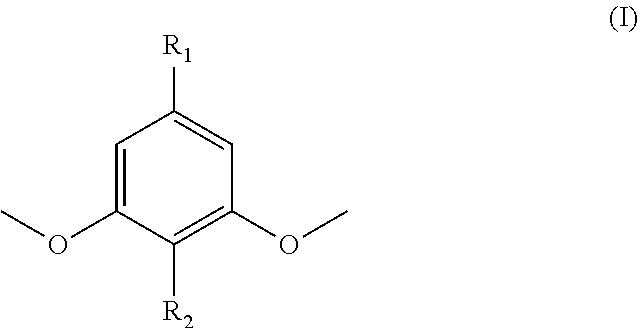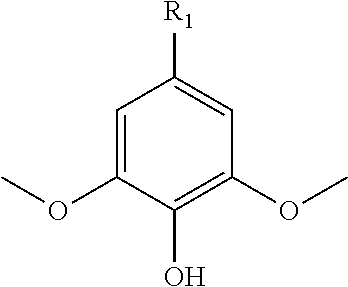Polymers prepared from functionalized dimethoxyphenol monomers
a technology of functionalized dimethoxyphenol and polymer, applied in the field of polymerizable monomers, can solve the problems of lack of actual examples of high molecular weight macromolecules, and achieve the effects of higher glass transition, low thermodynamic stability of polymer, and rapid polymerization
- Summary
- Abstract
- Description
- Claims
- Application Information
AI Technical Summary
Benefits of technology
Problems solved by technology
Method used
Image
Examples
examples
Synthesis and Purification of Syringyl Methacrylate
[0095]Syringol (99%, Fisher Scientific, used as received) was acylated with 1.02 molar equivalents of methacrylic anhydride (94%, inhibited with 2000 ppm Topanol® A, Sigma-Aldrich, used as received) using catalytic amounts of 4-dimethylaminopyridine (DMAP, >99%, Sigma-Aldrich, recrystallized from toluene), a reaction temperature of 60° C., and reaction times between 24 h and 72 h. Syringol-to-Syringol Methacrylate conversions of >60 mol-% were achieved at higher DMAP contents (i.e., 0.06 mol / mol DMAP / methacrylic anhydride). After washing the syringyl methacrylate product in dichloromethane with a saturated sodium bicarbonate solution, 1.0 M NaOH, 0.5 M NaOH, 1.0 M HCI, and deionized water and then concentrating the product by rotary evaporation, the syringyl methacrylate was fractionated to high purity using a heat-decant-cool cycle in either hexanes or petroleum ether. The monomer / hydrocarbon mixture was heated to reflux while stir...
PUM
| Property | Measurement | Unit |
|---|---|---|
| Tg | aaaaa | aaaaa |
| Tg | aaaaa | aaaaa |
| glass transition temperatures | aaaaa | aaaaa |
Abstract
Description
Claims
Application Information
 Login to View More
Login to View More - R&D
- Intellectual Property
- Life Sciences
- Materials
- Tech Scout
- Unparalleled Data Quality
- Higher Quality Content
- 60% Fewer Hallucinations
Browse by: Latest US Patents, China's latest patents, Technical Efficacy Thesaurus, Application Domain, Technology Topic, Popular Technical Reports.
© 2025 PatSnap. All rights reserved.Legal|Privacy policy|Modern Slavery Act Transparency Statement|Sitemap|About US| Contact US: help@patsnap.com



